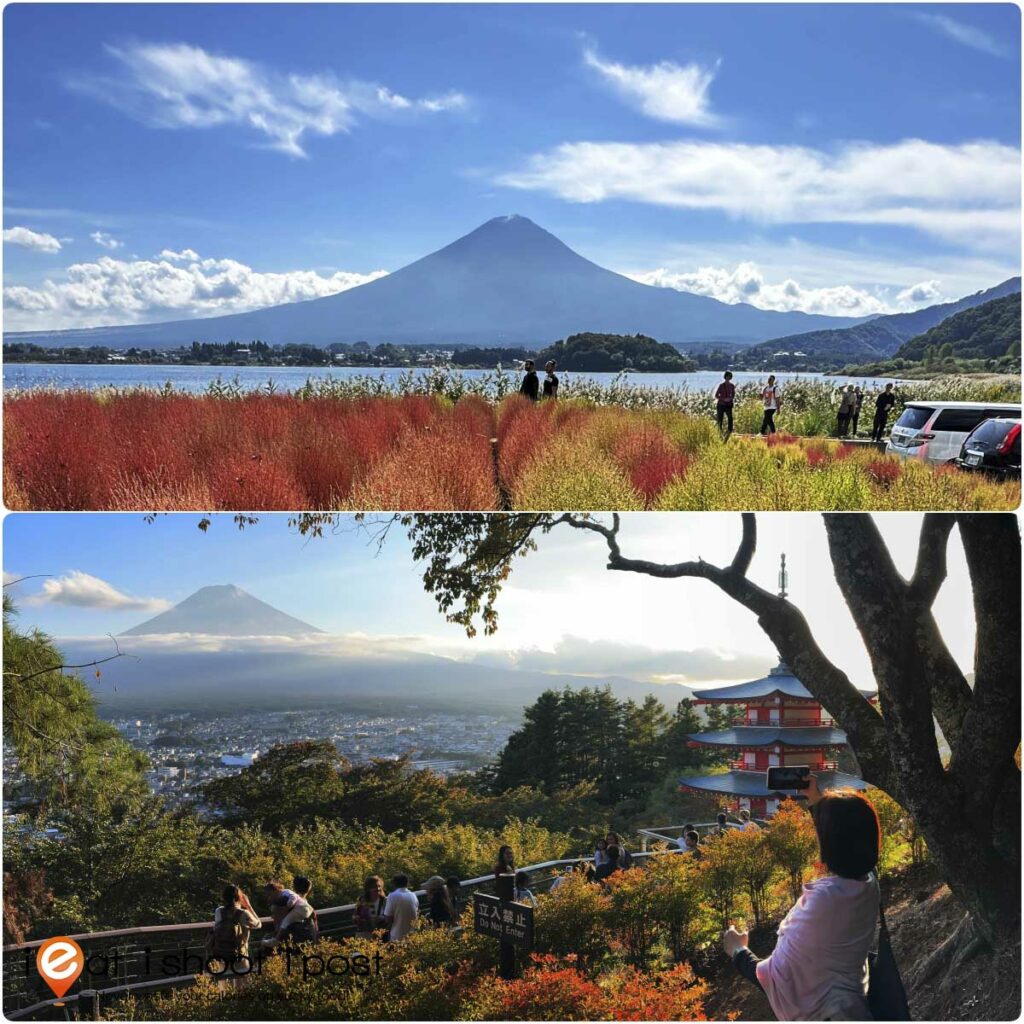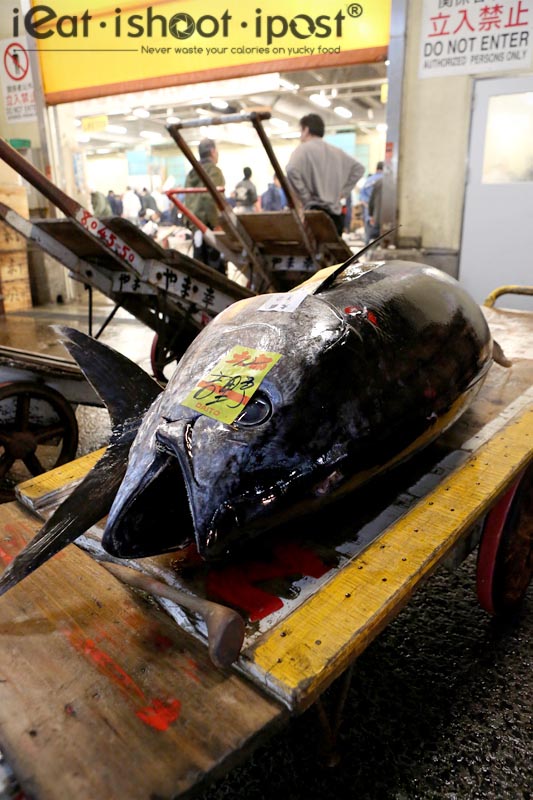
When you order Akami-dane (red flesh fish) at a Sushi bar, you will invariably be given Tuna. Unlike Shiromi-dane (white flesh fish) which include fish like Tai (Sea Bream), Hirame (Olive Flounder) and Kanpachi (Amberjack), there is essentially only one fish that qualifies as Akami-dane and that is Tuna. But the piece of “Tuna” can come from a few sub-species which can range from $1 for two pieces at a low end Sushi Bar to beyond $20 at a super high end place. And just because you paid $20 for a mouthful of maguro (tuna) does not necessarily mean you got your money’s worth unless you really know what you are getting. So it pays to have a little knowledge and to be able to let your Sushi Chef that you know how to talk Tuna!
To get a perspective of what the Japanese Sushi Tsu consider Tuna that is worth eating, my friend Hisato arranged for me to be picked up at 4.30am in the morning so that we can get to Tsukiji market to witness the fresh tuna auction. Now, if you have seen photos of the Tuna auction before, you might notice that sometimes the Tuna are fresh, whiles at other times the Tuna are frozen. The reason for this is that the fresh Tuna are considered the premium grade Tuna which can cost 10 times more than the frozen variety and their auction starts first before the buyers go to the next room to bid for the frozen Tuna. The fresh Tuna auction is not opened to tourists, but fortunately, Hisato managed to organize special passes for us to get in!
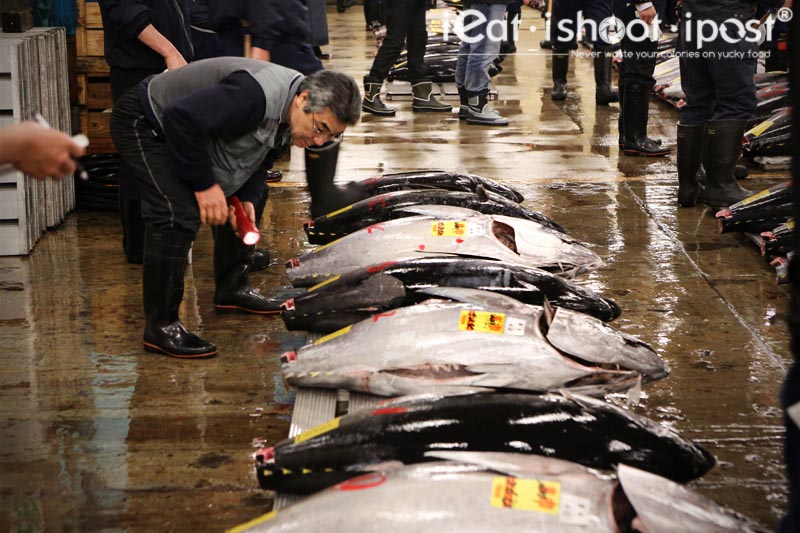
Tuna are sometimes considered the “Ferrari” of the oceans as these amazing fish have the ability to cruise for up to 70km/h for long periods of time. This is made possible by the presence of iron rich myoglobin in its muscles which give it that red colour. It is the same compound that gives beef and lamb its red colouring too, so it is not surprising that many describe Tuna as having a beefy, metallic taste. However, because it lives in the ocean and doesn’t need to support its own weight like land animals, the flesh is much more tender than beef. Tuna are also unique as they have the ability to raise their body temperature above the temperature of the surrounding water unlike other fish which are strictly cold blooded. This allows them to swim in frigid waters and extends their range tremendously.
This unique ability is precisely what makes Tuna so delicious. Their high energy muscles contains lots of mitochondria which breaks down in to delicious flavour compounds called inosinate which work synergistically with glutamates (MSG) to create that umami sensation on your palate. That is one of the reasons why Tuna goes so well with soy sauce which are high in glutamates.
The most prized Tuna are the bluefin tuna which are called Hon-maguro. (Hon – 真- meaning real in Japanese). But just because you are served Hon-maguro doesn’t mean it is necessarily the best Tuna. There are actually three distinct species of Bluefin tuna and they are all considered Hon Maguro or what the Japanese also refer to as Kuro (Black) Maguro. The largest come from the Atlantic ocean and are the fish which the Italians traditionally catch in a ritual called the matanza where the fish are channeled with giant nets into a cul de sac where they are landed by hand. These are the Atlantic Bluefin (thunnus thynnus) which can grow to a length of 4.58m and weigh nearly 700kg.
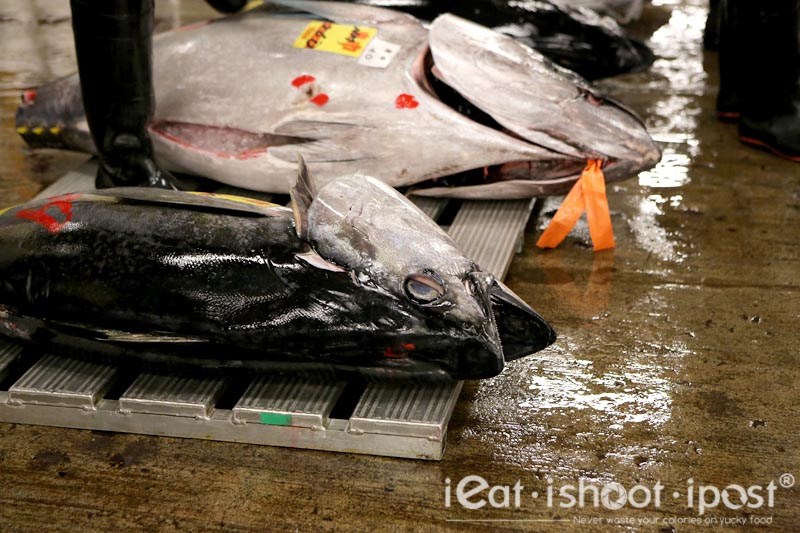
Then there is the Southern bluefin tuna (thunnus maccoyii) which are found in the Indian Ocean between 30 and 50 degrees latitude. These Bluefin tuna are smaller in comparison to their Atlantic cousins, they only grow to 2.45m and weigh up to 260kg. If you are sitting at the Sushi Bar and you are told that the piece of tuna is Minami (Jap – south) Maguro, then it refers to the Southern Bluefin. In Singapore, you often come across Minami Maguro because the Australians catch them at the juvenile stage in the Great Australian Bight and transport them to Port Lincoln where they are matured and fatten for the market.
However, the prized Bluefin in the eyes of the Japanese are the Pacific Bluefin (thunnus orientalis) which are caught in the local waters off Japan. These grow to a maximum of 3m and can weigh up to 450kg. Earlier in January this year, a Pacific Bluefin tuna was auctioned for US$736,000, setting a new record for the price of Bluefin Tuna! And the auction for that Tuna occurred right here at the fresh Tuna auction room!
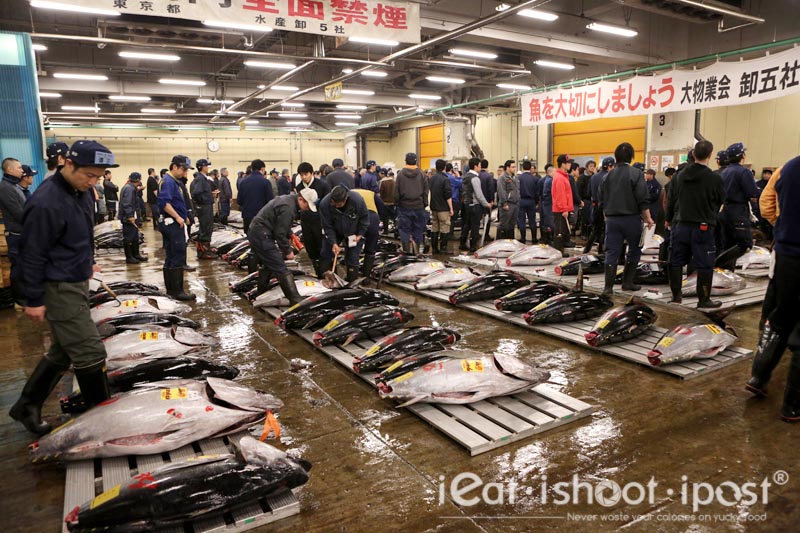
There are two other species of Tuna that you might be served at the Sushi Bar, viz the Yellowfin tuna (thunnus albacares, Kihada) and Bigeye (thunnus obesus, Mebachi Maguro). Both of these are often used for Akami but they lack the Otoro of the Bluefin tuna. Both of these tuna are known as “ahi” in Hawaii. If you are paying $1 for a piece of maguro sushi, then they are likely to come from these and are most probably frozen. Right at the bottom end of the quality scale are bright cherry red coloured tuna. If you see this, then walk away quickly because the Tuna has been treated with odourless smoke (carbon monoxide). The carbon monoxide turns the flesh into a bright red colour giving the impression that the tuna is fresh when it could be as stale as moldy bread! This practice is not allowed in Singapore, but you might come across it if you are dining overseas. So be very suspicious if you have been served a cheap piece of tuna with an eerie bright red hue!

Just before the auction begins, the potential buyers make their rounds to inspect the fish. They usually do this by feeling the texture of the meat from the cut tail end of the tuna. This is really one of the critical points in the value chain that ends up as a $20 piece of Sushi on your plate. Experts like our host, Yamaguchi-san who has been trading Tuna for generations are able to tell the quality of a fish by instinct and thus bid for the best Tuna. So Sushi Chefs rely on his expertise to obtain the very best tuna for their Sushi shop.
However, he doesn’t sell his tuna to just anybody. Most of his buyers has had a long time relationship with him and Yamaguchi-san must be convinced that they are able to properly handle the Tuna before he would sell to them. So the best Tuna are usually bought by a handful of Tuna traders who already have an established clientele of Sushi Chefs which they sell to. This is why it is not easy for a newbie to open a Sushi restaurant in Japan.
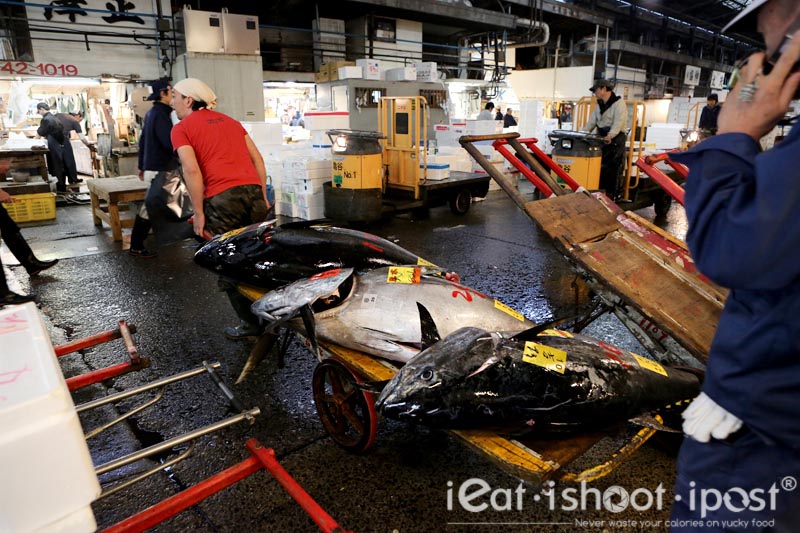
And it is even harder if you are a Sushi Chef in Singapore. I spoke with Chef Ronnie Chia of Tatsuya who recounted how he had courted Yamaguchi San for years before he finally agreed to supply Tuna to him. It took a lot of persistence and a skin that is thicker and tougher than a whale shark, but eventually he got his first shipment and since then has been serving his excellent Tuna at his restaurant.
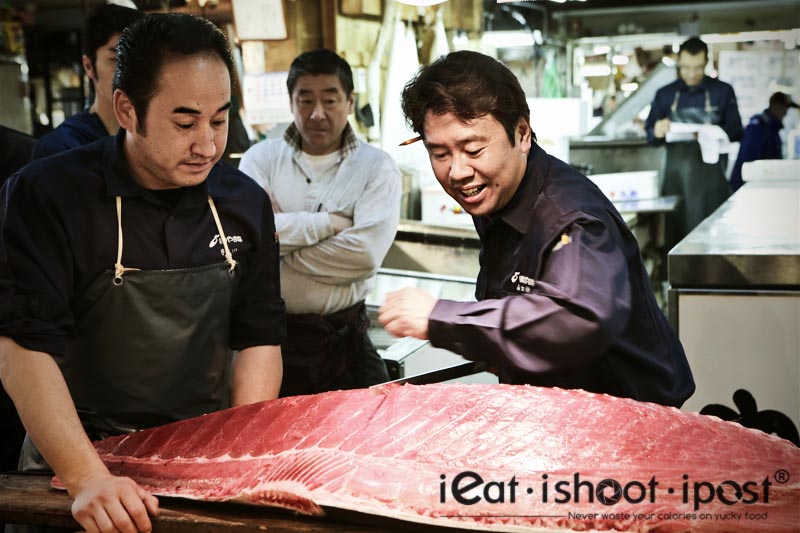
Immediately after the auction, the tuna are placed on Tuna “Rickshaws” and carted to the retail shops where the fish are filleted and cut into blocks. The scene at Tsukiji is a typical picture of modern Japan where technology and tradition exist comfortably side by side. Here is one of the most technologically advanced countries in the world with arguably the world’s most advance toilet seats, able to customize water fountains to suit backsides of different shapes and sizes and yet this whole Tuna auction thing still seems so technologically inept!
The task of sectioning the Tuna is always done by Yamaguchi-san who determines the price of the blocks as well as who it will be sold to. So you can appreciate just how much a good relationship with him plays such an important role in that piece of tuna that eventually ends up on your sushi plate!
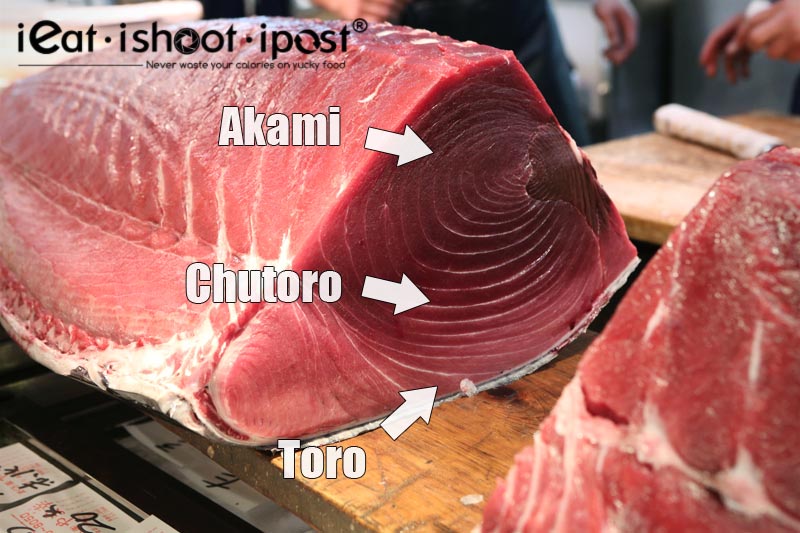
The unique feature of Tuna flesh is that filigreed white fat intersperse between its bright red flesh. It is just about the only fish that has marbling that looks like Wagyu beef. The fat in Tuna is found on the outer portions of the fish and also around its belly and functions as insulation to keep the core temperature of the fish warm. So the flesh just under the skin is more fatty than the flesh near the backbone and this is called the Toro. The lean red meat that forms the bulk of the fish is known as the Akami and the transition zone between them is called the Chutoro.
If you speak to the older Japanese folk, they actually prefer to eat Akami as this is traditionally the portion of tuna that is favoured in old Japan. It wasn’t until after the war that the Japanese started to eat more fat and the fattier cuts became popular. Akami is in fact very tasty especially when it has been marinated in soy sauce ie Maguro Zuke and is well worth trying especially if your Sushi Chef tells you that it has been cut from a fresh Tuna block!
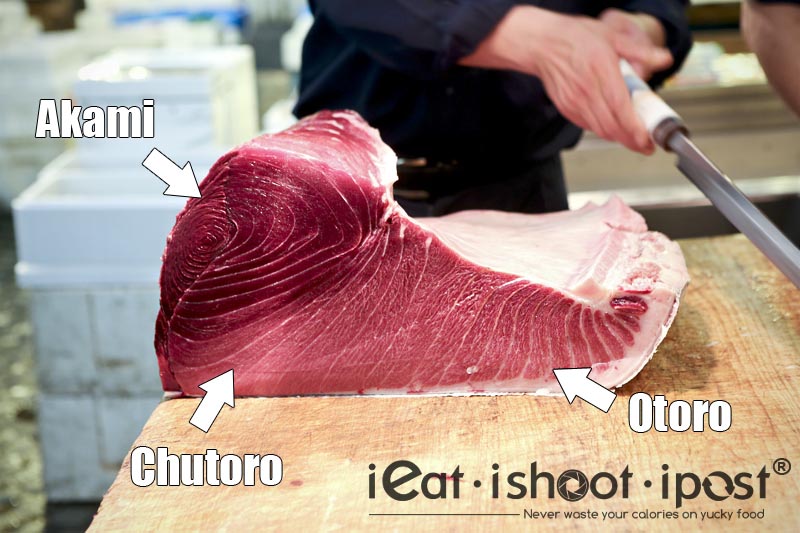
The most prized portion of the Tuna that I am sure everyone is familiar with is the Otoro which is the fattiest portion of the tuna. That is section of the Tuna that surrounds the belly. The distinctive feature of Otoro, aside from the increased marbling, is the inter-muscular fascia that separates the flesh into distinct layers. The fascia tends to be a little chewy which is why I personally prefer Chutoro (its also cheaper) to Otoro although I would not refuse it if offered a slice.

Sometimes, your Sushi Chef might offer you a slice of intricately marbled piece which doesn’t have the characteristic layers of Otoro. This is probably cut from the section near the neck of the Tuna and is known as Shimofuri (snow frost). Needless to say, this piece of tuna is highly sought after and doesn’t come cheap!
Conclusion
The Bluefin Tuna is truly and amazing and unique fish. It is unfortunate that it has been overfished and is now facing an uncertain future. There is some light over the horizon though, as the Japanese have started to farm Tuna that have been hatched from eggs. These tuna are now available in Singapore and are known as Ten-qoo Maguro. They are a better alternative to the wild Bluefin Tuna but of course, they don’t taste the same.
The way things are going, Tuna might one day be like Beef where all the meat comes from farmed animals. The trend seems to be inevitable. So what kind of attitude should we adopt? Shall we avoid eating it? Unless we all do, the fishing is not likely to stop. Should we eat Bluefin quickly now when wild stock is still available before there is a total ban on the fishing? This is an issue that any conscientious foodie would have to grapple with in our age of diminishing resources.





